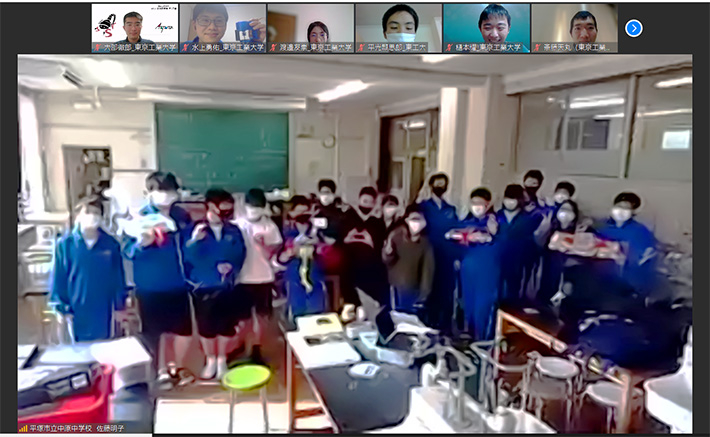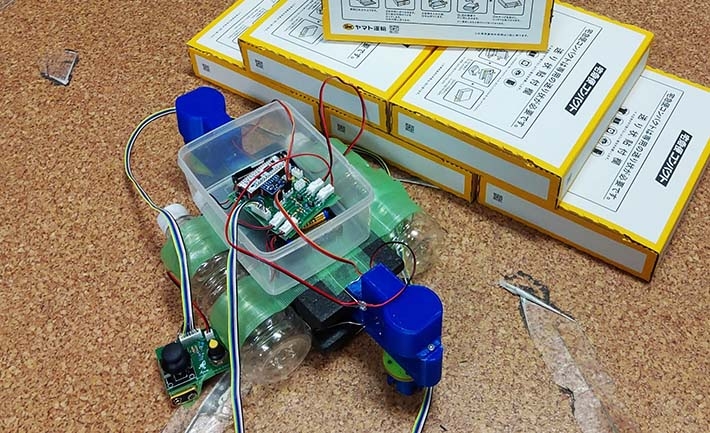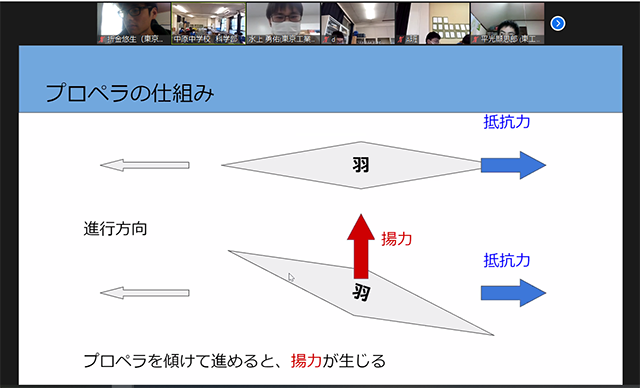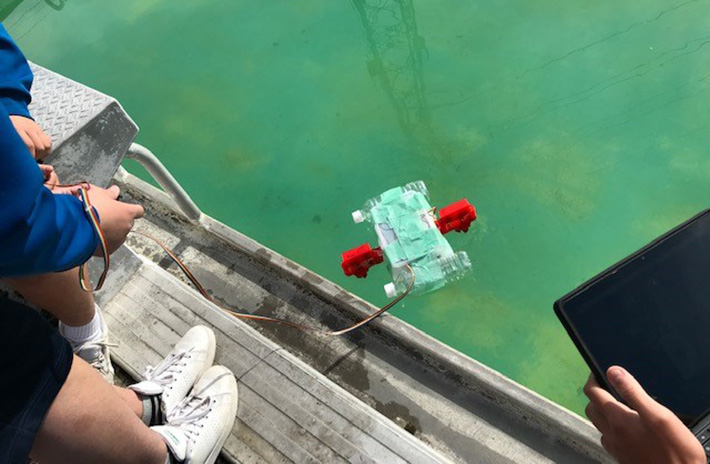Members of the Aqua Lab from the Society for the Study of Robotics — an official Tokyo Tech student club — hosted three robotics workshops for students of the science club at Nakahara Junior High School in Hiratsuka City, Kanagawa Prefecture in December 2021. Sixteen middle school students joined these workshops, supported by the science education support arm of the Tokyo Tech Fund, to create their own amphibious robots.

Commemorative photo of middle school students and Aqua Lab members
The "Omniboat" was developed by members of the Aqua Lab as a kit that allows users to create a boat-shaped water robot. It includes two cycloidal propellers that are actually used in small boats that need to make minor turns, providing the robot with the ability to take on various propulsive directions and positions. Many of the parts of the Omniboat were created using a 3D printer to allow mass production as a kit. In addition to the propellers, components include parts for the frame, the original circuit board, microcontroller, sensors, and other electronic parts. Once the frame and circuits have been assembled, users can write their own program or use a provided program to operate the water robot.

Assembled Omniboat and packaging
In response to the continuing COVID-19 pandemic, the Omniboat was originally developed as an amphibious robot that could be created at home by new Tokyo Tech students joining the Aqua Lab at the Society for the Study of Robotics. After hearing about the potential educational effects of the Omniboat, the science club at Nakahara Junior High School proposed that members of Aqua Lab hold a workshop where the youngsters can learn more about the robot. Before sharing the kits with the students, Aqua Lab revised the assembly instructions, circuits, and programs to make them more suitable for younger participants.
On days 1 and 2 of the online workshops, Tokyo Tech students offered simple lectures on the Omniboat kits. The middle school students then split into groups to assemble the robot under the guidance of Aqua Lab members. While the online environment presented some challenges, all groups were able to complete the assembly with the cooperation of the local teachers and by referring to the instructions and images prepared in advance. It took the youngsters approximately three hours to complete the project, but they remained focused and throughout seemed to enjoy the assembly until the end.

Online lecture session explaining how to assemble prepared kit
On the final day, teams applied the prepared code to their completed robots and tested them in a pool. The hull for the robot was not provided in a kit and had to be created by the middle school students themselves. Some elaborate designs emerged, and while not all groups were completely successful in their experiments, the students seemed to feel a sense of accomplishment once they had balanced their creations and were able to move them in the water.

Testing out Omniboat created by middle school students
Comments from Aqua Lab members
- Yusuke Mizukami, 3rd year, Earth and Planetary Sciences
- Tomotaka Watanabe, 3rd year, Systems and Control Engineering
This is the first time for members of the Aqua Lab to hold an event like this, which aimed to spread the joys of science and technology. The Omniboat was not originally designed for educational purposes, so when we received this request from the middle school, we were concerned about whether the students would really enjoy it. However, when the workshops were actually held, we could see online that these students really enjoyed working together on the project, and although there were some minor problems, we were able to successfully complete the event. This event also helped us think about the connection between our specializations and the public. It would bring us great joy if this experience helps the students of Nakahara Junior High School to create robots in the future.
Comments from participating middle school student
The workshops were also interesting, but moving the robot was the most enjoyable part. I was a little disappointed as the first time I tried, I could not move the robot forward. However, thanks to a suggestion from a Tokyo Tech student, it moved forward without any problems during my second try. Another challenge was assembling the robot. Seniors students did most of the work building the robot, but I decided to do what I could to help, so I did some soldering and assembling of parts. I think I was of some use during the process. The robots made by the university students were amazing. My dream is to become a programmer, so I will try to make a robot that can compete with those made by the university students. I really enjoyed this event. I can only thank the Tokyo Tech students for giving me the precious experience of building a robot with my group, and for making such a fun kit to assemble. Thank you, students of Tokyo Tech!
- *
-
All affiliations were accurate at the time of the event.






